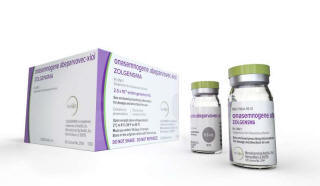Health, mind & body? Subscribe to the Prevention magazine. Now available in Pakistan
|
|
|||
|
|
For Healthy Foods Subscribe to Dalda ka Dasterkhuan Rs 1400
|
||
Pakistan's premier website that covers current affairs and news.
At $2M, priciest ever medicine treats fatal genetic disease
U.S. regulators have approved the most expensive medicine ever, for a rare disorder that destroys a baby's muscle control and kills nearly all of those with the most common type of the disease within a couple of years.

The medicine, sold by the Swiss drugmaker Novartis, is a gene therapy that treats an inherited condition called spinal muscular atrophy. The treatment targets a defective gene that weakens a child's muscles so dramatically that they become unable to move, and eventually unable to swallow or breathe. It strikes about 400 babies born in the U.S. each year.
The Food and Drug Administration on Friday approved the treatment, called Zolgensma, for all children under age 2 who are confirmed by a genetic test to have any of the three types of the disease. The therapy is a one-time infusion that takes about an hour.
Share your views at editor.newsflash@gmail.com

Most read stories
Will you die from Coronavirus? Here is answer to a difficult question.
British Airways to resume Pakistan flights next week after a decade
Theresa May to resign as prime minister
Zakir Musa: India's 'most wanted' killed in Kashmir
The independent nonprofit group Institute for Clinical and Economic Review, which rates the value of expensive new medicines, calculated that the price of the new gene therapy is justifiable at a cost of $1.2 million to $2.1 million because it "dramatically transforms the lives of families affected by this devastating disease."
The defective gene that causes spinal muscular atrophy prevents the body from making enough of a protein that allows nerves that control movement to work normally. The nerves die off without the protein
In the most common type, which is also the most severe, at least 90% of patients die by age 2, and any still alive need a ventilator to breathe. Children with less-severe types become disabled more slowly and can live for up to a couple decades.
Zolgensma works by supplying a healthy copy of the faulty gene, which allows nerve cells to then start producing the needed protein. That halts deterioration of the nerve cells and allows the baby to develop more normally.
In patient testing, babies with the most severe form of the disease who got Zolgensma within 6 months of birth had limited muscle problems. Those who got the treatment earliest did best.
Babies given Zolgensma after six months stopped losing muscle control, but the medicine can't reverse damage already done.
Evelyn Villarreal was one of the first children treated, at eight weeks. Her family, from Centreville, Virginia, had lost their first child to spinal muscular atrophy at 15 months. Two years later when Evelyn was born a test showed she also had the disease, so the family enrolled her in the gene therapy study at Nationwide Children's Hospital in Columbus, Ohio.
Evelyn is now 4½ years old and showing no muscle problems other than minor trouble standing up, said her mother, Elena Villarreal. She has been feeding herself for a long time, she draws and speaks well, and will be starting kindergarten in the fall.
"She's very active and goes to the playground a lot," said Elena Villarreal. "She's walking and even jumping."
It is too early to know how long the benefit of the treatment lasts, but doctors' hopes are rising that they could last a lifetime, according to Dr. Jerry Mendell, a neurologist at Nationwide Children's. Mendell led one of the early patient studies and is Evelyn's doctor.

Early diagnosis is crucial, so Novartis has been working with states to get genetic testing for newborns required at birth. It expects most states will have that requirement by next year.
The FDA said side effects included vomiting and potential liver damage, so patients must be monitored for the first few months after treatment.
Send your contributions at editor@newsflash.com.pk
